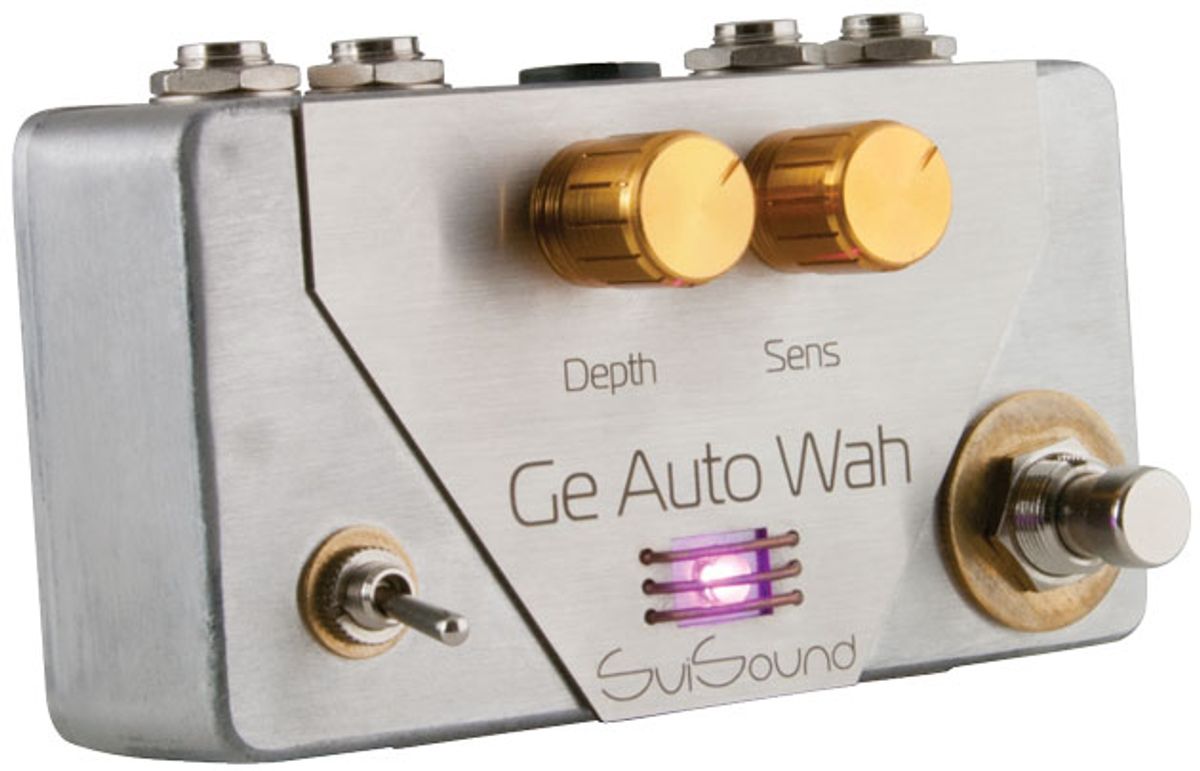
This germanium-driven auto wah delivers uncommon sensitivity and soft filtering effects.
The Ge Auto Wah is the newest pedal from the SviSound workbench. It’s a true germanium wah filter that uses Soviet-era Russian transistors to deliver a touch sensitive, dynamic auto-wah that adds tons of texture without sounding heavy-handed.
Metal on MetalSuited up in a funky collision of copper, brass, and steel, the Ge Auto Wah looks like something from a sci-fi western, or a lost prop from Waterworld. Inside, the hand-soldered circuit provides evidence of a very hands-on company. There’s not much spare room in the pedal’s interior, so a 9V adaptor is required—no battery option.
The depth knob pinpoints the variable sweep of the wah effect, while the “sens” knob sets the filter level. As on an old Mu-Tron, there’s a range switch that determines the frequency emphasis. The up position focuses on the low-mids-to-high-mids range, while the down position emphasizes the mid-to-high spectrum. The pedal is also available with two extra jacks, which let you insert another effect—a fuzz, say—in the auto-wah’s loop.
A Polite Filter Effect
The Ge Auto Wah can do door-slamming, on/off filtering if that’s what you need. But what often makes it a joy is its relative subtlety. It rewards finesse and is exceptionally sensitive to picking dynamics. It can display a vowel-like softness that makes the filtering feel forgiving—and usable in many contexts.
Ratings
Pros:
Cool textures over rich filter tones.
Cons:
Setup can be tricky if moving from guitar to guitar. No battery option.
Tones:
Ease of Use:
Build/Design:
Value:
Street:
$165
SviSound Ge Auto Wah
svisound.com
The pedal is highly sensitive to pickup type. The spiky output from the single-coils of a Fender Jaguar demand careful sens control tweaking. A Gibson Les Paul was easier to dial in. But once you get the Ge pegged for your setup, it has a vocal quality that’s less like the heavy, almost caricatured guffaw that Jerry Garcia was fond of, and more like subtle sweeps from a nice wah pedal.
Sensitive Settings
Careful use of the depth and range controls is critical. Thumping away on the sixth string at the first few frets at low settings can result in loss of mid and treble detail, which may mean you have to boost the signal elsewhere. That said, these lower reaches can sound insanely cool when you set the range toggle as wide as possible. That way, low depth settings evoke the tough, guttural cough of a cocked wah. I especially enjoyed the range toggle in its wider setting. With the depth just shy of noon (a sweet spot for single-coils) I got a great low-end squawk and great pick sensitivity. It also gave high-end content a nice glimmer.
If you use dirt with the Ge Auto Wah (an experiment I heartily recommend), placement is key. I found that fuzz placed before the Ge Auto Wah is a real output killer. But if you place your fuzz after the filter, you can summon touches of Hendrix’s drawling, fast-and-funky wah sweep, as well as colorful and muscular filter tones that are killer for percussive leads. Curiously, I had the best results with high-sustain silicon-transistor dirt boxes like a “ram’s head” Muff clone, which seemed to better drive the whole frequency spectrum through the filter sweep.
The VerdictThe GE Auto Wah could be a revelation for players who have only experienced inexpensive auto wahs. It excels at adding texture and harmonic color—it’s definitely not the sort of dull filter effect reminiscent of throwing a blanket over your amp and lifting it off again. It’s super responsive to picking dynamics and adds soft contours—when you want them—to an effect that isn’t always easy to master.
